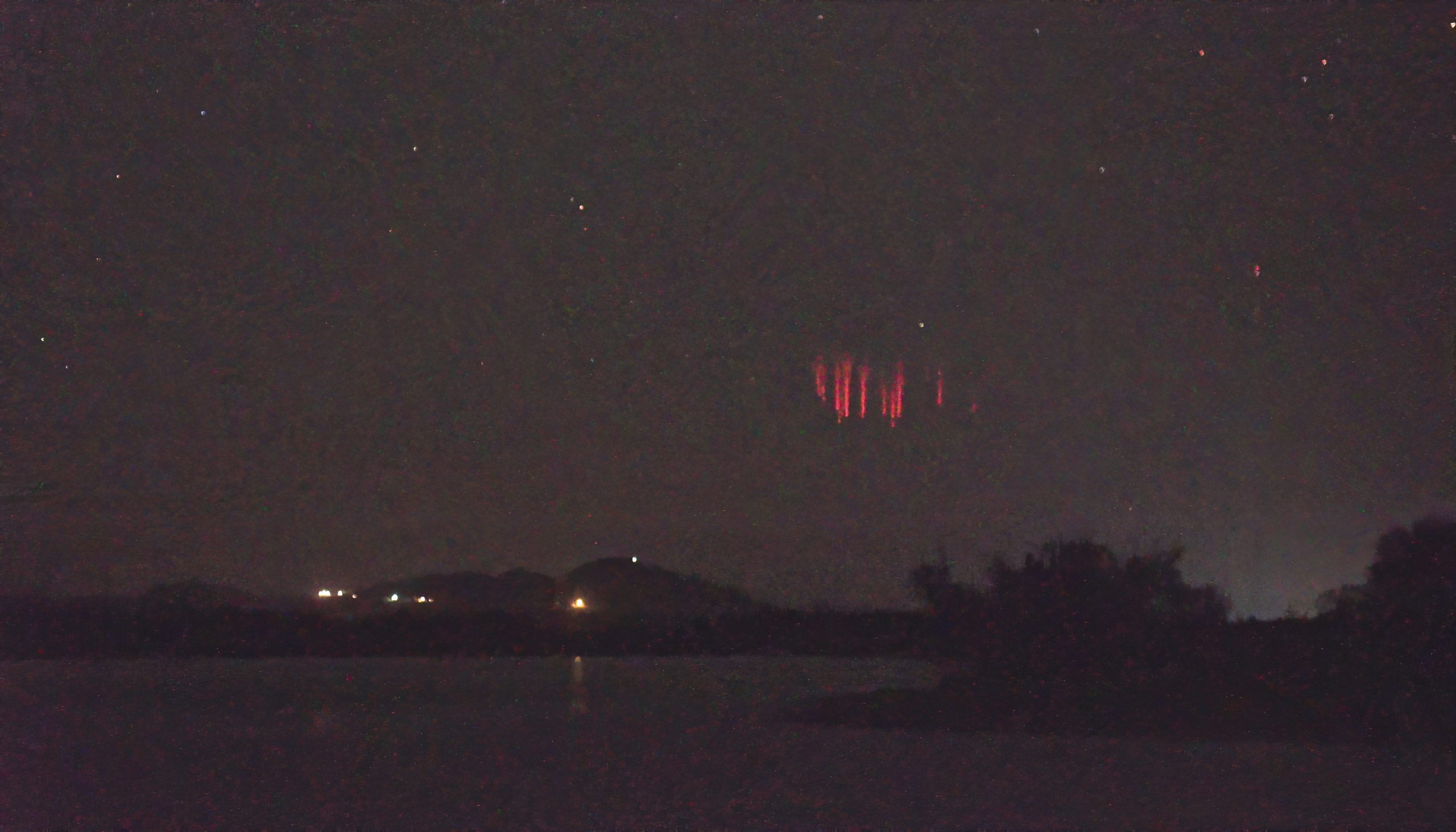THE GREAT SPRITES CHASE
A NASA scientist and night-sky fanatic chase the elusive lights across Oklahoma.
The odds are not in their favor.
By Lina Tran
It wasn’t dark enough. We’d driven east for two hours from Oklahoma City, and still, a stubborn red light blinked from a nearby wind farm. Paul Smith sighed with frustration and drove on. When we left the hotel earlier that night, just two stars blinked in the sky. Light from a gas station and bowling alley, and, farther away, the bright halo of the city, outshone the rest. With each passing mile, past fields and onto tumbling dirt roads, more stars wriggled into focus. The city haze shrunk in the rearview mirror, and the sky darkened. But it wouldn’t do for Smith, who wanted the darkest skies he could find.
Smith is a night-sky fanatic and photographer. His obsession is sprites: immense jolts of light that flicker high above thunderstorms. Last October, he guided NASA scientist Dr. Burcu Kosar through the backroads of Oklahoma to catch one herself. Although she’d studied sprites for more than 15 years, she hadn’t yet chased one. My colleague Joy Ng and I, members of NASA’s communications team, tagged along for the ride.
Aside from their fleeting nature, sprites have little in common with their fairy-like namesakes. The towering sparks materialize around 45 miles above the ground or higher (most commercial airplanes fly at an altitude of five to seven miles). The clusters can stretch 10 miles across and 30 miles top to bottom. They take on complex shapes. “They’re like snowflakes; none are identical,” Kosar said. There are carrot sprites that look like a bunch pulled right out of the ground, tops, roots, and all. There are column sprites, majestic angels, and the white whale of sprite-chasing: jellyfish.
Sprites are elusive, but regular features of our skies. They have been detected over land and sea alike across most of the globe. Triggered by lightning, they appear at the boundary between the atmosphere and space.
But for something so widespread, many questions surround the science of sprites, such as how they affect the upper atmosphere and Earth’s global electric circuit. Sprites briefly alter the electrically charged layers of the upper atmosphere, which is home to communications signals like radio. Changes there can disrupt those signals.
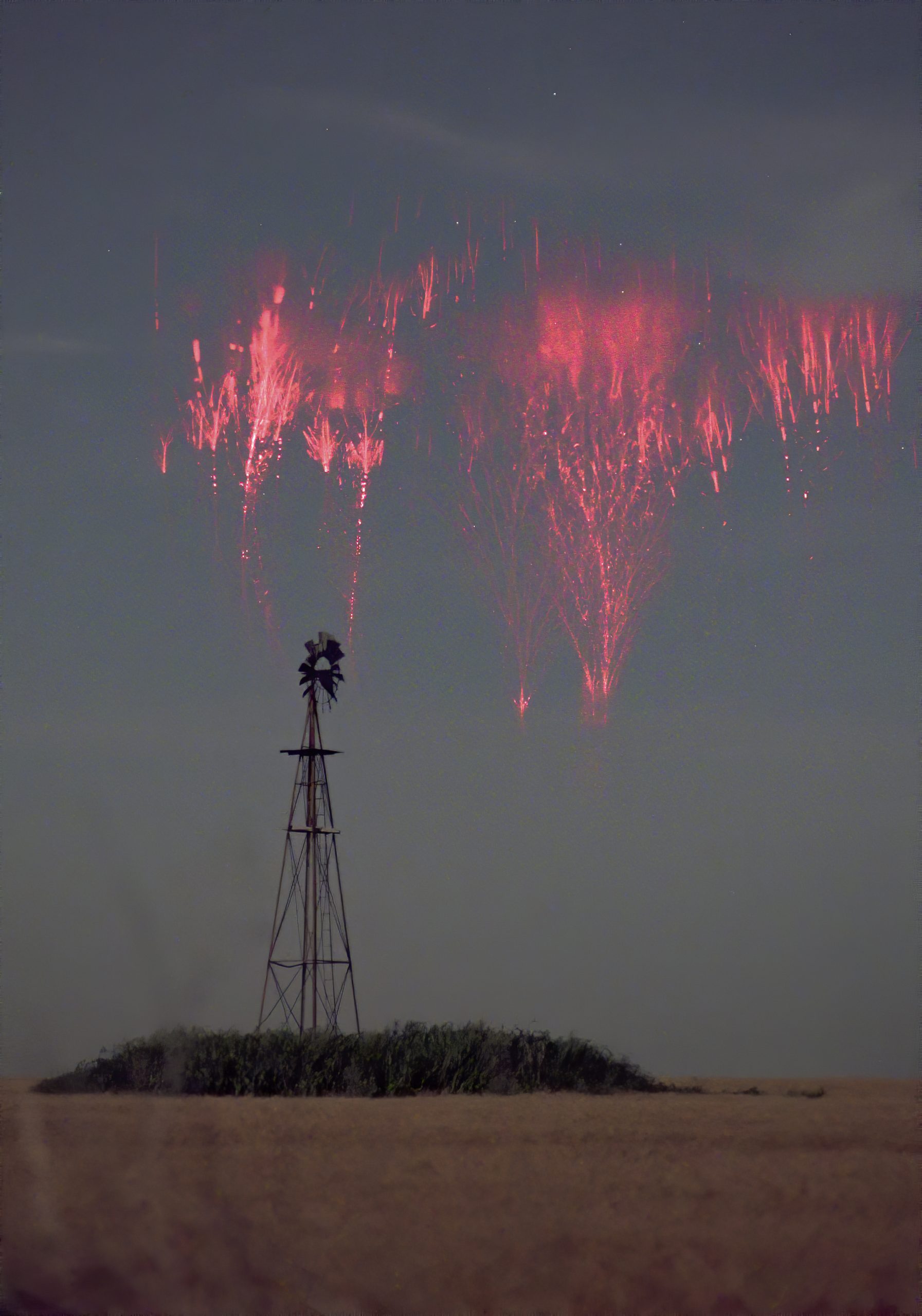
By gathering images of the slippery phenomena from sprite-chasers, Kosar, who is based at NASA’s Goddard Space Flight Center in Greenbelt, Maryland, hopes researchers can use this ground-based data to shed light on some of these questions. Her new citizen science project, Spritacular, invites sprite-chasers like Smith from around the globe to share their observations. The goal is to build a community where researchers and citizen scientists can share information and construct the first crowd-sourced sprite database.
Sprite-chasing could be considered a safer form of storm-chasing. A menacing storm is desirable. But because sprites appear above thunderstorms, for any hope of spotting one, you must look for them from far away. If the thunderstorm is overhead, not only will you get soaked, but any sprite will be obscured by clouds. Smith considers the sweet spot to be 100 to 300 miles away — far enough to see above the clouds. “You’re threading a needle between the storm strength, light pollution, and distance from the storm,” Smith said. Often, when he’s out driving, he notices spots that are dark, have a clearing where he can pull over safely and set up his cameras, and — even better — boast a beautiful view, maybe over a pond or next to a photogenic abandoned barn. He’ll drop a pin on a map in his phone — for later, should the weather take him that way again.
The first night of the chase, Smith was eyeing a storm cooking east of Oklahoma City. He pulled into a gravel lot between grassy fields and unpacked a heap of cameras and tripods, orienting them toward the inky east. Referring to the weather radar on his phone, Smith pointed our gaze in the storm’s direction. He estimated we were 150 to 200 miles away. Milky flashes of distant lightning pulsed low over the horizon. I didn’t even know I could see something so far away. We focused on the patch of sky about a fist’s width above the lightning: If the storm yielded sprites, that’s where they’d be.
Like fishing, sprite-chasing is characterized by long stretches of waiting interrupted by bursts of adrenaline that follow either the high of a successful catch or the loss of one that got away. Even with several cameras going, Smith caught countless frames of nothing but night. The longer we waited, the more our eyes adjusted to the dark. It became easier to detect the faintest motion in the sky: a plane, a satellite, a shooting star. “This is my therapy,” Smith said. The Milky Way stretched overhead. Slumbering cows grumbled their disapproval, and a party of coyotes yipped across the field.
An hour passed, and a gauzy blanket of clouds crept into view. “Clouds are our nemesis,” said Smith, defeated. Even if there were sprites, we wouldn’t be able to see them, so we packed our bags.
Oklahoma is a good place for sprite-chasing because the plains routinely generate fierce thunderstorms capable of producing them. But the height of sprite season runs from late spring to early summer when Oklahoma’s squalls are strongest. (On a good night, Smith might catch tens of sprites.) October was pushing it, but Smith and Kosar remained hopeful: A line of storms seemed to be rolling in from the southwest. The next day, we’d check the weather and try again.
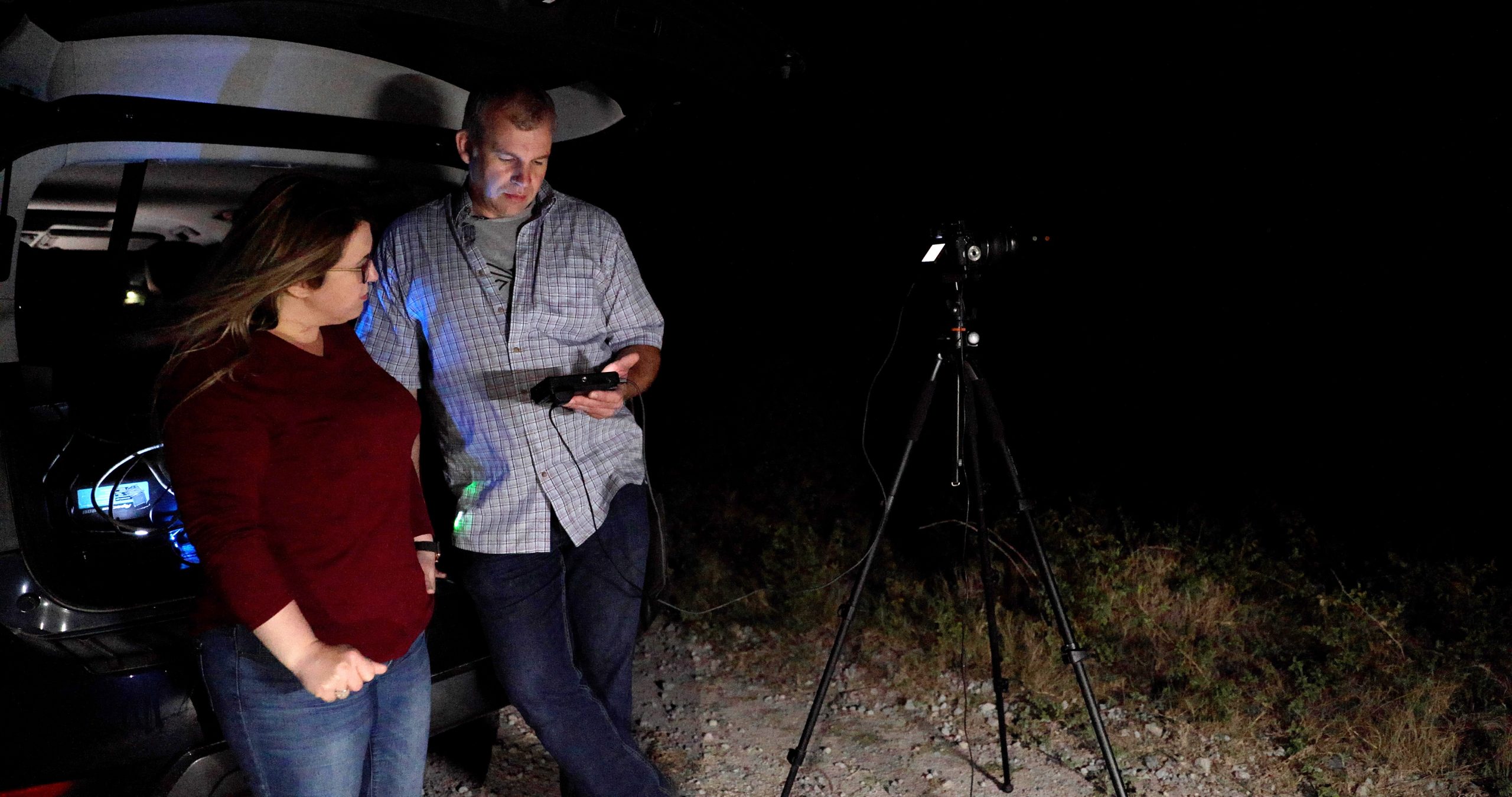
Written accounts of strange flashes of light linked to storms date back to the 1700s. The earliest known report comes from German legal scholar Johann Georg Estor, who in 1730 described viewing a storm from a mountaintop perch in Vogelsberg, when he saw flashes of light “directly up into the sky.”
More than 200 years later, the spectacle was just as bewildering. In the 1980s, NASA pilots described lightning that struck upward, some 2,000 feet above their flight path. The light “shattered in all directions as an egg would do if it were thrown against a ceiling,” they reported. Because their observations weren’t captured on camera, the lightning science community largely disregarded the accounts. In a way, Kosar said, the study of sprites began with citizen scientists.
In the summer of 1989, a team of University of Minnesota scientists was testing a low-light camera and inadvertently captured a glowing blob high above the clouds. Videos taken from the Space Shuttle between 1989 and 1991 offered another view of the strange events. These captures unleashed a rush of interest in the upper atmosphere’s electric spectacles. After a 1994 airborne campaign caught the first sprites in color, and triangulated their position above storms, they were dubbed “sprites” for their elusive nature. Now we know they are the most commonly observed of an entire wonderland of finicky phenomena known as transient luminous events, whose ranks include ELVES, TROLLs, gnomes, pixies, halos, blue jets, gigantic jets, and blue glimpses.
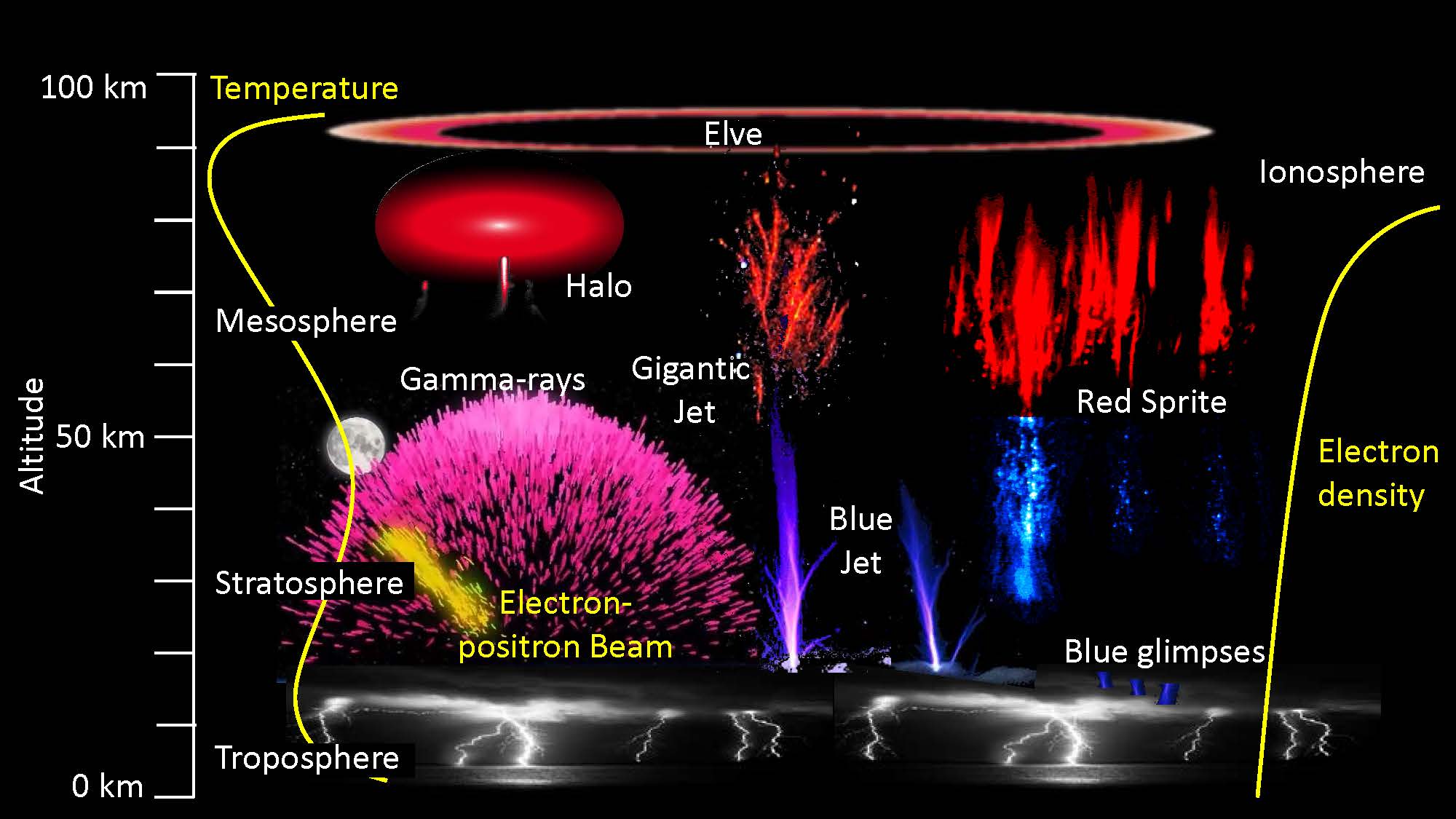
There are two flavors of cloud-to-ground lightning, the kind that triggers sprites: positive and negative, depending on what kind of charge they send to the ground. Sprites are generated mainly by positive lightning, which tends to be about 10 times stronger than the negative variety. The odds can be daunting. Negative lightning far outnumbers the positive, with only about 10% of all lightning strikes being positive. And not every positive strike creates a sprite; Kosar estimates about 2% of positive strikes are powerful enough to trigger sprites. They require mighty squalls fueled by lots of churning, or convection. This churning creates the complex electrical environments inside thunderstorms that give rise to lightning strikes.
It works like this: When positive lightning sends charge surging groundward, it suddenly creates an electric field in the air, above the thunderstorm. This field stresses the thin upper atmosphere, rapidly heating electrically charged particles there. When those excited particles interact with nitrogen in the atmosphere, they produce bright red flashes of light. Scientists call this an electrical breakdown: what happens when something that doesn’t usually conduct electricity — air, in this case — receives a huge voltage, causing electric current to suddenly flow through it.
For Kosar, sprites were an obsession at first sight. She had just finished her undergraduate degree when she first saw a video of sprites. On camera, sprites may look like they’re composed of branches of lights, but in reality, each branch is created by fast-moving balls of light that barrel down the sky, splitting into ever-smaller pieces. “They looked like fireworks,” Kosar said. “Since each is unique, I can look at them all day and never get bored.” While sprites were a passion of Kosar’s, she often found herself occupied with other research at NASA. Then, a friend tagged her in a post in a Facebook group — the International Observers of Upper-Atmospheric Electric Phenomena — and she was hooked again.
Created in 2013, the online community now numbers more than 7,000 observers of transient luminous events worldwide. When members learned of her expertise, they began tagging Kosar in their posts, asking her to identify their captures or explain unique features. That’s how she met Smith, an active member of the group. It became impossible for Kosar to answer all the questions, and she began dreaming of a citizen science project that would leverage the expertise of the observers and connect them with researchers like herself. “I really admire these people,” Kosar said. “Catching sprites is not easy. What they are doing is phenomenal.”
A NASA mentor of Kosar’s had had success building such a project for aurora chasers. Meanwhile, another Goddard colleague, upper atmospheric scientist Dr. Jia Yue, persuaded Kosar the idea was worth pursuing, after he invited her to give a lecture about sprites to his class. Together, they drafted a proposal and won a grant to kick off the project.
Since 1989, sprites have been studied from the skies, space, and ground, but there’s still much to learn about them. Scientists don’t understand why sprites are displaced from their parent lightning flash, how they take on so many different shapes and sizes, and — crucially — what impacts they have in the atmosphere. However, because they’re so massive, sprites influence huge swathes of the sky.

By gathering observations from sprite-chasers and information on where and when they made them, Kosar can build a catalog of sprites, which would help chip away at these problems. With accurate time and location data, scientists can connect those observations to satellite data and records from NASA’s lightning mapping arrays or the National Lightning Detection Network. That would allow researchers to find each sprite’s so-called parent flash and identify properties of that lightning strike. They could also pull information on conditions in the storm and atmosphere when the sprite was born. “Speaking as a scientist who’s enthusiastic about these things, working with sprites-obsessed citizen scientists is amazing,” Kosar said. “Together, we’re going to build an invaluable database.”
Seeing a sprite is a very different experience from catching a sprite. To the human eye, they are merely a flicker of light over the horizon. This speed belies their complexity. Armed with tripods, low-light cameras, and long exposures, sprite-chasers can reveal their fine details. This is yet another reason why dark skies are crucial: Light pollution would wash out the long exposures used to catch sprites. (With dark skies and an unobstructed view of a faraway storm, basic gear — like a DSLR camera on the right settings — can hook sprites successfully. But Smith admits to being a gearhead. Although we drove a large SUV that could seat six comfortably, the back half of the car was filled with camera gear.).
On the second night of sprite-chasing, Smith set his sights on a deluge brewing a couple hundred miles away. He scans the radar daily, looking for storms with potential. The more intense the storm, the higher the odds it will produce sprites. Radar indicates the strength of the storm and what direction it’s traveling in. At the beginning of the trip, my teammate and video producer Ng pressed Smith for his forecast of our week in town. But beyond a three-day forecast, “it’s pretty much reading tarot cards,” he told her.
Smith had always been fascinated with the night sky. He spent many winters working as a surveyor in Canada’s Northwest Territories, stomping through snow aglow with the green light of the auroras. He captured his first sprite by accident. He was in the Mojave Desert, photographing the Perseid meteor showers, when he noticed the glint of distant lightning. A lifelong photographer, he snapped a photo. Later, he looked at the image and spotted a thin red line above the lightning. He’d heard of sprites before but was amazed to learn it was possible to capture them on camera. Since then, any sprite he caught was no accident, but the product of dogged planning.
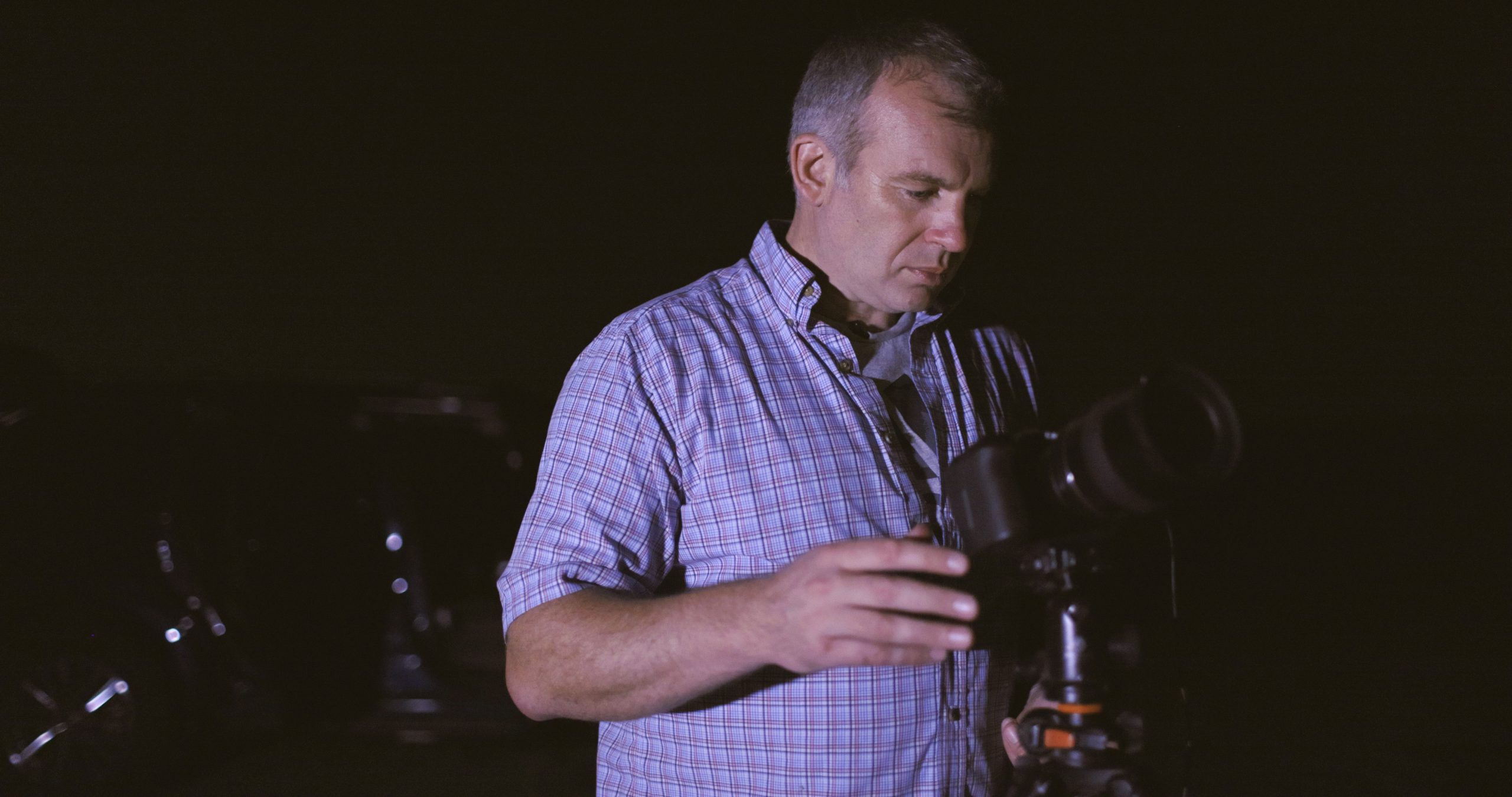
“I suffer from FOMO,” Smith said. The fear of missing out on a sprite — that’s what compels him to drive night after night. When he does capture a sprite, he thrills at the knowledge that no one else in the world has seen what he has or caught what he did. Nighttime photography was a way for him to share what goes on while others slumber, each photo a glimpse of a world in which the sky exhibits all kinds of strange behavior.
And so, weather and life permitting, Smith chases sprites as often as he can. He has self-imposed a 2-hour-drive limit for promising storms — the farther you drive to catch a sprite, the farther you must drive to get back home — but it’s easy to convince himself to press farther. When we met him, he was also training to be a nurse; the long shifts followed by days off suit his nocturnal obsession. In a good month, he might go out 15 to 20 nights.
Our second spot was not so different from the first, at least as far as we could tell at night. It was remote, empty, and far from the city. Crickets chirped in the grass, armadillos rustled nearby. We’d spent some time driving around, trying to avoid a flashing light from a wind turbine, but the empty field was the only place with a clear view. We parked on an unpaved road and looked east.
The light annoyed Smith, who admitted to being a perfectionist. “I just find even the smallest light so oppressive,” he said. “Out here it’s like beautiful sky, beautiful dark, then — eep, eep!” He made a high-pitched beeping sound. I knew what he meant. Beneath the dark sky, those disturbances become loud as a shriek. I tried to focus on the patch of sky above the lightning, but the blinking tugged my gaze its way.
We shuffled on our feet, debating whether we should get back in the car and drive on for a better vantage point. Smith interrupted with a yell. “Sprite!” He hopped to the left, caught off-guard. “That was a sprite!” he said. A giddiness set over him, but he soon realized that he hadn’t yet unpacked the gear or set up his cameras. This was, he said, a classic rookie mistake. I chided myself for not catching the blip of light with my own eyes. Still, our moods lifted. If the clouds produced one sprite, surely they could produce more.
Once the chase begins, it’s difficult to stop. There’s always the hope of another flash. Five minutes more grows into 10, then 20, then 30. Then, suddenly, it’s 1 a.m. and you still have to drive home. After a couple hours, the pause between flashes of lightning grew longer. The storm was dying down. Smith had seen a sprite, but not caught it. Bleary-eyed and empty-handed, we packed our bags. It was a quiet drive back in the early morning, and the fluorescent city greeted us upon our return.
By the last night of sprite-chasing, the group was weary. We’d logged at least 700 miles of driving across Oklahoma. Everyone was low on sleep — twice that week, we’d gone to bed between 3 and 5 a.m. — and still, there were no sprites preserved on our camera’s memory cards. We agreed to push it for the last night of the trip, driving three hours southeast of the city to get within range of a growing storm over the Oklahoma-Arkansas border.
We set up on the shore of Sardis Lake, a reservoir dotted with shadows of islands and surrounded by gentle hills. The wide ribbon of the Milky Way unrolled above us. Kosar and Smith conferred over the radar. Something was not right. During the drive the system weakened. When we set out for the park, lightning strikes flared every 100 seconds. Now, the sky flashed every 1,000 seconds or so. Kosar faced the horizon, willing lights to appear.
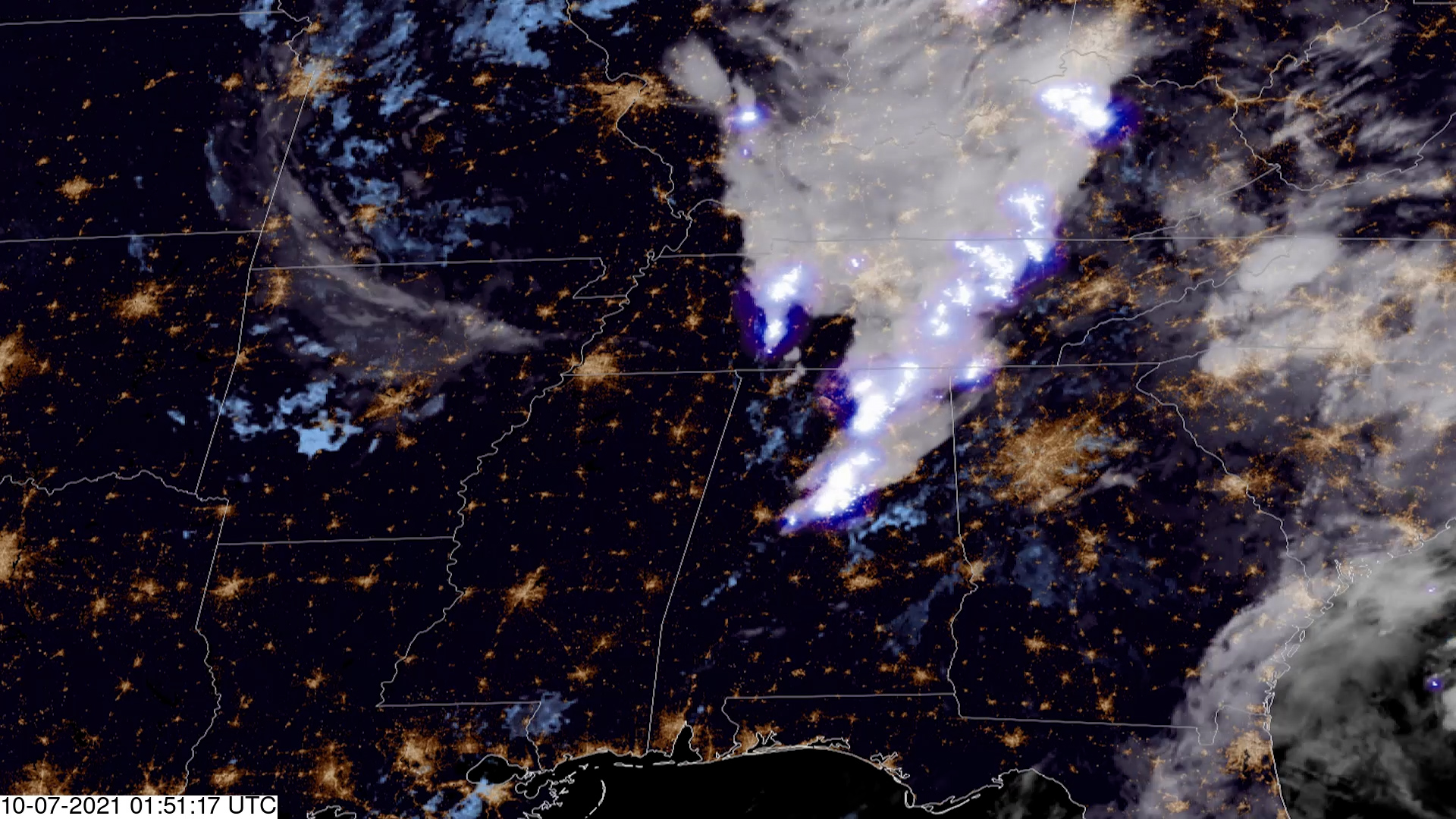
Meanwhile, a thunderstorm nearly 400 miles away, somewhere in Mississippi, teased Smith. He checked the radar and shook his head. “I just know it’s spriting over there,” he said. He worried about the long range, but the storm looked — as he put it — juicy. He proposed driving to another spot in the park, into its line of sight. The group agreed it was worth a shot, and we packed and unpacked the gear once more.
We set up camp on a thin land bridge slicing through the lake. The water lapped quietly at the roadside. Smith showed Kosar how to fish for sprites in video — immediately punching “record” after each flash of lightning; later, individual images could be isolated from the video. She frowned with concentration. The horizon flashed like a weak heartbeat. The night was clear and calm, even as we witnessed the sky break into a storm two states away.
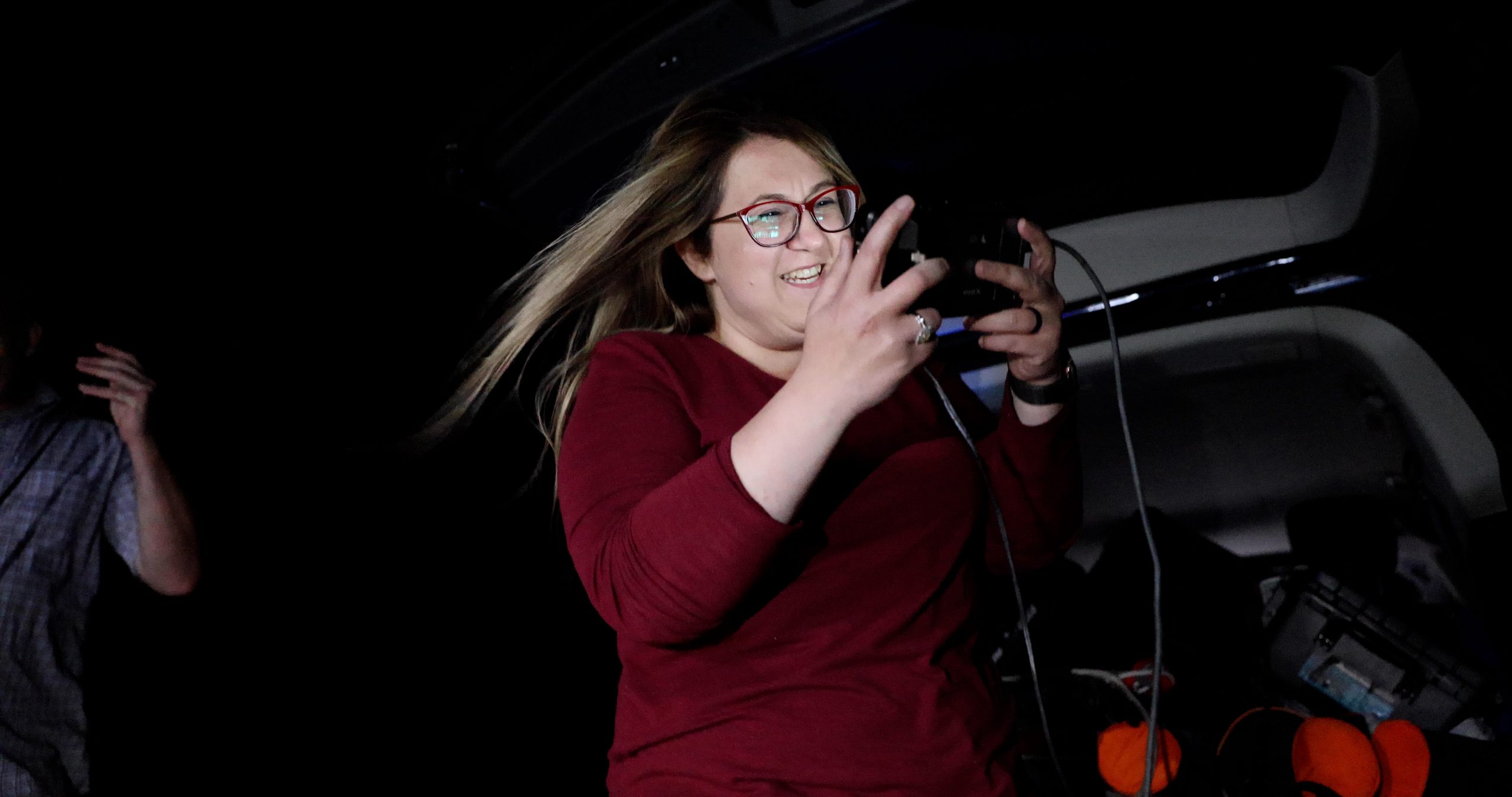
Light interrupted the dark sky, and a shout broke the silence.
“Sprite!” Kosar and Smith yelled. They peered at the camera and replayed the recording, giddy with excitement. Eight strokes of red light darted into view: a set of column sprites.
“You can’t even yell the word ‘sprite’ before it’s over,” I said. “Not even ‘s’,” Kosar said.
Ng and I hadn’t spotted the sprite with our own eyes, but took satisfaction in witnessing a successful capture. Kosar played the recording over and over, and we cheered every time the columns flitted on screen. “I see how addictive this is,” she said. “I never want to leave.” She’d caught one sprite, and now she wanted another.
We dawdled that night, delaying our departure. I thought of the sprites we might have missed on the drive or sprites that might appear after we left, with no one around to see. The next time a storm raged overhead, I would think of sprites again. At 1 a.m., we tore ourselves away. Above, the deep sky seared with potential.♦
